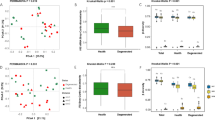Abstract
An igapó forest near the confluence of Rio Tarumã Mirim (Tarumãzinho) and Rio Negro has been studied. It is a typical ectotroph forest with a raw humus layer and suppressed litter decomposing activity by Higher (i.e., carpophore-producing) Fungi. The number of the latter is about one-fifth of that observed in the (anectotrophic) terra firme forest. All ectotrophically mycorrhizal fungi observed belonged in three families:Amanitaceae, Boletaceae, Russulaceae. Leguminosae are dominant, and of theseAldina latifolia andSwartzia cf.polyphylla were demonstrably ectomycorrhizal. The scarcity of mineral nutrients in the soils of igapó, campinarana and campina is overcome by direct cycling through ectomycorrhizae. This is in contrast to other black- and white-water inundated forest communities in Amazonia.
Similar content being viewed by others
References
Adis, J., 1981: Comparative ecological studies of the terrestrial arthropod fauna in Central Amazonian inundation forests. — Amazoniana7 (2, 87–173.
- inSioli (seeSioli).
—, 1979: Litter production of a Central-Amazonian blackwater inundation forest. — Tropical Ecology20 (2, 236–244.
Gadgil, R. L., Gadgil, G. D., 1971: Mycorrhiza and litter decomposition. — Nature233, 133.
—, —, 1975: Suppression of litter decomposition by mycorrhizal roots ofPinus radiata. — New Zealand J. For. Sci.5, 33–41.
—, —, 1978: Influence of clearfelling on decomposition ofPinus radiata litter. — New Zealand J. For. Sci.8, 213–224.
Harley, J. L., 1969: The Biology of Mycorrhiza. 2nd ed. — London: Leonard Hill.
Hüeck, K., 1966: Die Wälder Südamerikas. — Stuttgart: Gustav Fischer.
Keel, Kuo, S. H., Prance, G. T., 1979: Studies of the vegetation of a white sand black-water igapó (Rio Negro, Brazil). — Acta Amazonica9, 645–655.
Litten, W., 1982: ⋯ and in Amazonia. — McIlvainea5, 34–36.
Mikola, P., 1973: InMarks, G. C., Kozlowski, T. T., (Eds.): Ectomycorrhizae. — New York, London: Acad. Press.
Singer, R. inSioli (seeSioli).
—, 1984: Adaptation of Higher Fungi to várzea conditions. — Amazoniana8, 311–319.
—, 1979: Litter decomposition and ectomycorrhiza in Amazonian forests.1. A comparison of litter-decomposing and ectomycorrhizalBasidiomycetes in latosol-terra-firme rain forest and white sand podzol campinarana. — Acta Amazonica9, 25–41.
—, —,Ivory, M. H., 1983: The ectotrophically mycorrhizal fungi of the neotropical lowlands, especially Central Amazonia (Litter decomposition and ectomycorrhiza2). — Beihefte zur Nova Hedwigia77, 1–339.
—, 1960: Ectotrophic tree mycorrhiza and forest communities. — Ecology41, 549–551.
Sioli, A., 1984: The Amazon — limnology and landscape ecology of a mighty tropical river and its basin. — Monographiae Biologicae. The Hague: Junk.
Takeuchi, M., 1962: The structure of the Amazonian vegetationVI. Igapó.—J. Fac. Sci., Tokyo, Sect. 33. Bot.8 (7, 297–304.
Author information
Authors and Affiliations
Additional information
Litter Decomposition and Ectomycorrhiza in Amazonian Forests3. Previous contributions seeSinger & Araujo (1979) andSinger & al. (1983).
Rights and permissions
About this article
Cite this article
Singer, R., Aguiar, I.A. Litter decomposing and ectomycorrhizalBasidiomycetes in an igapó forest. Pl Syst Evol 153, 107–117 (1986). https://doi.org/10.1007/BF00989420
Received:
Issue Date:
DOI: https://doi.org/10.1007/BF00989420




